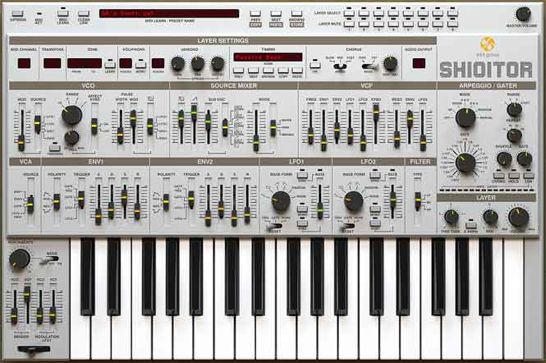
D16 Group have introduced Shioitor, a new software synth with “authentic analogue character and extensive software features”.
Here’s a rundown of what Shioitor offers:
Layers
- 8 independent sound layers
- each layer can be assigned to different key zone, midi channel
- each layer has its own settings and parameters: polyphony, arpeggiator, chorus and sound -parameters
- dynamic signal routing from layers to outputs
- mute for each layer
Oscillators
- ultra high quality band limited oscillators (non-audible aliasing output up to 22khz for base frequency of the note)
- two base oscillators: square with PWM and sawtooth
- suboscillator with 5 different waveforms to choose
- noise oscillator with 3 different colours to choose
Filters
- no aliasing at high resonances and high frequencies
- constant-Q and very warm filters
- three filter modes: LP, HP and BP
Sound control
- two multipurpose synchronizable LFOs with 6 different waveshapes
- two multipurpose envelopes with 4 different trigger modes
Sound effects
- built-in chorus effect
- flexible unisono with tune, panorama and filter spread
Preset management
- two kinds of presets: per layer and full set of layers
- presets organised into groups
Midi management
- advanced midi event assignement system
- midi learn function
- ready at hand simple modulation matrix for modulation and pitch bend wheels
Arpeggiator
- 6 work modes
- full synchronisation
- 21 different time bases
- built-in gater/chorder
- tunable step length
- tunable shuffle
Description:
Since it uses a layered architecture, Shioitor has endless sound shaping possibilities. Each layer can be freely assigned to any midi channel or keyboard zone. Its audio output can be routed to any of the available audio outputs. Layers can either be used to create a single massive sound (where all layers respond to a single midi channel and a single keyboard zone) or to create many different timbres (where each layer plays a sound on a different midi channel). Using Shioitor to play a different sound on each midi channel allows Shioitor to work very efficiently as it saves memory and CPU compared to loading in multiple instances of the plugin for each sound.
Shioitor can work as either a monophonic synthesiser or a polyphonic synthesiser, where each layer can play up to 16 voices of polyphony (dependent on CPU of host computer). These settings are independent for each layer. Also, each layer can have its own independently controlled arpeggiator. In both play modes (mono/poly), it is possible to turn on a Unison mode with tweakable parameters for spread, filter cut-off frequency, panorama and tune. Unison mode will use up polyphony. However, it allows the creating of bigger more defined sounds.
Shioitor also has a built in chorus effect. This can be used instead of Unison mode to fatten a sound or it can be used with Unison mode enabled to create much bigger richer sounds. The chorus effect was modelled on classic analogue units, the same type found on old synthesisers. The chorus setting have been reduced to a few parameters with discrete values to make it easier and faster to use.
Shioitor is also equipped with an excellent Preset Manager tool which organises presets into groups. It also has a Timbre Manager which allows searching for layers and arpeggiator sequences within presets. Shioitor comes with a huge library of presets created by famous artists. This allows users to get up and running quickly. However, for those who love to experiment and create their own sounds, Shioitor will keep them busy for many hours as they become lost in its incredible array of sonic possibilities!
Pricing and release date are to be announced.

D-16 apps are the schit!!!!! long live the TR and TB hardware through virtual emulators!!!!!
does it make more beautiful or interesting or at least more original sounds, or does it make more convincing and pleasant emulations of analogue synthesizers like the old oberheim roland korg yamaha, if compared to other commercial plugins?